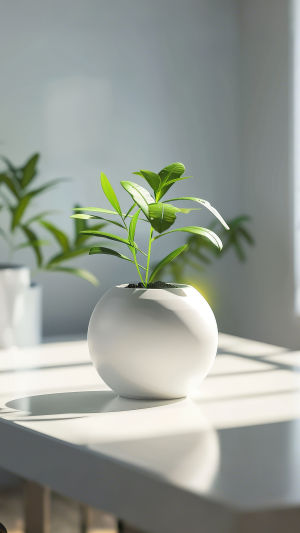Have you ever wondered how plants survive without eating like animals do?
While they don't bite into a sandwich or sip smoothies, plants have a magical process that lets them make their own food—no shopping, no cooking, just sunlight and science!
Let's take a journey into the fascinating world of plants and find out how they turn light into life.
<h3>What Is Photosynthesis?</h3>
Photosynthesis is the process by which green plants use sunlight, carbon dioxide, and water to make their own food. It happens mainly in the leaves and is powered by a green pigment called chlorophyll. This pigment captures light energy and converts it into chemical energy that plants use to grow.
In simple terms, photosynthesis can be expressed by this equation:
Carbon dioxide + Water + Sunlight → Glucose (food) + Oxygen
That's right—plants not only make their own food, but they also give off oxygen, which we breathe in. It's a win-win for both plants and animals!
<h3>The Role of Chlorophyll</h3>
Chlorophyll is the key player in photosynthesis. Found in chloroplasts within the cells of plant leaves, it absorbs light most efficiently in the blue and red parts of the spectrum while reflecting green light (which is why plants look green). Without chlorophyll, plants would not be able to convert sunlight into usable energy.
<h3>Where Photosynthesis Happens</h3>
Photosynthesis mostly takes place in leaves, which are uniquely designed for this job. The flat shape of a leaf increases the surface area to capture sunlight, and the tiny pores on the underside of the leaf—called stomata—allow carbon dioxide to enter and oxygen to leave. Inside the leaf, a network of cells called mesophyll contains the chloroplasts where photosynthesis happens.
<h3>Why Do Plants Need Glucose?</h3>
Glucose is a type of sugar that serves as the primary food source for the plant. Once it's made, the plant uses glucose for energy to perform essential functions such as growth, repair, reproduction, and storage. Some of the glucose is stored as starch in roots (like carrots), stems (like sugarcane), or seeds (like rice).
<h3>The Importance of Sunlight</h3>
Sunlight is the energy source that powers photosynthesis. The sun's rays provide the energy needed to split water molecules (H₂O) into hydrogen and oxygen. The hydrogen is used to make glucose, while the oxygen is released into the air.
That's why plants need to be placed in spots where they get enough sunlight. If they don't receive light, photosynthesis slows down or stops, and the plant eventually dies from lack of energy.
<h3>How Plants Absorb Water and Carbon Dioxide</h3>
Plants absorb water through their roots, which pull moisture up from the soil. Special tubes called xylem carry the water from the roots to the leaves. Carbon dioxide, on the other hand, enters through the stomata in the leaves.
The balance of water and carbon dioxide is crucial. Too little water and the plant can't transport nutrients. Too little carbon dioxide and the process of glucose formation slows down.
<h3>What Happens to the Oxygen?</h3>
The oxygen produced during photosynthesis isn't used by the plant itself—it's released into the air. That's great news for us, because humans and animals rely on that oxygen to breathe. In fact, forests and oceans (through algae) are the largest contributors to Earth's oxygen supply.
<h3>How Do Different Conditions Affect Photosynthesis?</h3>
Several factors can impact the rate of photosynthesis:
• Light intensity: More light usually means faster photosynthesis.
• Carbon dioxide concentration: More CO₂ can boost the process.
• Temperature: Too hot or too cold can slow down enzyme activity.
• Water availability: Without enough water, the process can't happen.
These conditions explain why plants grow better in spring and summer, when days are longer and warmer, and there's usually more rain.
<h3>Do All Plants Photosynthesize the Same Way?</h3>
Most plants use a process called C3 photosynthesis, but some have evolved special adaptations:
• C4 plants (like corn and sugarcane) are more efficient in hot, sunny environments.
• CAM plants (like cacti) conserve water by opening their stomata only at night.
These adaptations allow plants to survive in a wide range of climates—from tropical jungles to dry deserts.
<h3>Why Is Photosynthesis So Important to Life?</h3>
Without photosynthesis, life on Earth wouldn't exist as we know it. Plants form the base of the food chain, feeding herbivores, which in turn feed carnivores. More importantly, photosynthesis keeps the planet's atmosphere in balance by absorbing carbon dioxide and releasing oxygen.
It also plays a vital role in controlling climate, preventing erosion, and maintaining ecosystems. In fact, scientists are even studying ways to mimic photosynthesis in technology to create clean energy.
<h3>Final Thoughts: A Marvel of Nature</h3>
Next time you see a plant basking in the sun, remember—it's not just sitting there. It's hard at work capturing sunlight, taking in carbon dioxide, and transforming water into the sugars it needs to thrive. Photosynthesis is one of the most remarkable and essential processes on Earth.
Do you have plants at home or in your garden? Try observing how their leaves turn toward the light and imagine all the science happening inside. The more we understand nature, the more we can appreciate the quiet genius of green life all around us.





